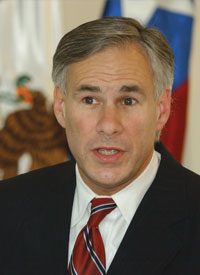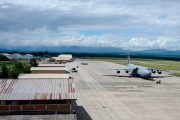
Item: In a speech in El Paso, Texas, on May 10, President Obama mocked those who have resisted his policies on illegal immigration and border security. “They wanted a fence. Well, the fence … is now basically complete,” said the President. He predicted, as noted in the official White House transcript, that opponents would probably now say we “need to quadruple the Border Patrol. Or they’ll want a higher fence. Maybe they’ll need a moat. (Laughter.) Maybe they want alligators in the moat. (Laughter.) They’ll never be satisfied.” Moreover, said Obama, “despite a lot of breathless reports” about crime, “El Paso and other cities and towns along this border are consistently among the safest in the nation.”
Item: On the CBS Early Show, on May 11, Bill Plante reported that the President “went all the way to the Mexican border to make the case for immigration reform, trying to get over the heads of the Republicans who are blocking it here in Washington.” Obama, he said without giving any opposing views, “has answered the complaints of Republicans about border security.”
After showing a film clip of the President’s deriding of his opponents, Plante went on: “What the President is calling for doesn’t stand a chance in this Congress: the path to citizenship for 11 million undocumented immigrants, a visa reform for students and agricultural workers, and allowing the children of undocumented immigrants to go to college or serve in the military. But Mr. Obama wants to make sure that the independent voters that he’ll need next year know that he’s working on border security, and that the Hispanic voters know who to blame if nothing happens.”
Correction: The President couldn’t get his amnesty and other pro-illegal alien schemes through Congress when his own party held both houses as well as the White House, but that hasn’t stopped him from trying to pin blame on others for holding up his agenda. His opponents, he suggested while making fun of Republicans, wouldn’t mind turning border-jumpers into gator food.
The fact is that about 70 percent of Americans surveyed have said they oppose his initiatives. Rather than taking another hit to his popularity, Obama went along with the Democrat congressional leadership in both 2009 and 2010 in not bringing an immigration bill to the floor.
The President more recently has thrown around enough statistics to muddy the waters of the Rio Grande as part of his attempt to generate support within his political base for the next election. At the same time, he and his Homeland Security Secretary Janet Napolitano are doing what they can to portray themselves as hard-liners on the law.
But, as the old line goes, statistics are sometimes like a bikini: What they reveal is suggestive, what they conceal is vital.
In this case, the President, to be charitable, is being disingenuous. The claims of the Obama administration belie what is happening on both sides of the Mexican border. The assertion that the border barrier is “basically complete” didn’t draw guffaws from his friendly crowd, but it should have. As columnist Charles Krauthammer scoffed:
“Complete? There are now 350 miles of pedestrian fencing along the Mexican border. The border is 1,954 miles long. That’s 18 percent. And only one-tenth of that 18 percent is the double and triple fencing that has proved so remarkably effective in, for example, the Yuma sector. Another 299 miles — 15 percent — are vehicle barriers that pedestrians can walk right through.
Obama then boasted that on his watch 31 percent more drugs have been seized, 64 percent more weapons — proof of how he has secured the border. And for more proof: Apprehension of illegal immigrants is down 40 percent. Down? Indeed, says Obama, this means that fewer people are trying to cross the border.
Interesting logic. Seizures of drugs and guns go up — proof of effective border control. Seizures of people go down — yet more proof of effective border control. Up or down, it matters not. Whatever the numbers, Obama vindicates himself.
Unfortunately for the President, or fortunately for the truth, there are some actual facts available. Evidence from a government report reveals that less than five percent of the southern U.S. border has secure double fencing. That is not “basically complete.” When there are more than a half-million illegal border-crossings annually, one cannot honestly call the frontier secure.
The union representing border agents, the Border Patrol Council, is not buying what Secretary Napolitano is trying to sell — namely, that the border is more secure than ever before. The council says her statements are “wrong and give a false sense of security.”
Texas Attorney General Greg Abbott also backs up those working on the border, noting that huge sectors are not secure and that violence along the frontier is mounting. As Abbott put in the Houston Chronicle for May 18:
Just three months before the president proclaimed the border secure, the U.S. Government Accountability Office revealed that the Border Patrol still lacks “operational control” over 55 percent of the border. According to the GAO, the Border Patrol acknowledges that more than half of the nation’s 1,954-mile southwest border is “not acceptable for border security.”
The situation in Texas is worse. The GAO reported that Texas’ stretch of the border is by far the least controlled — and therefore least secure — of any southwest border state. In the Marfa sector, for example, the Border Patrol exercises operational control over just 10 percent of the border.
The director of the Texas Department of Public Safety recently testified to Congress that 70 percent to 90 percent of the Texas-Mexico border “is only being monitored as opposed to managed or controlled” by the Border Patrol.
One day following the President’s claim that “he had ‘answered’ our border security concerns — and that cartel violence is really only a problem in Mexico — Texas law enforcement officials told Congress a very different story,” said the Attorney General, who then went on to summarize a litany of the crimes and violence attested to by the lawmen.
The White House apparently hasn’t been able to use its eraser on all the statistics at the Justice Department. To be sure, crime, especially narcotics-related violence, is worse on the Mexican side, but that doesn’t mean the U.S. side of the border is Shangri-La. The latest report of the Executive Office for the United States Attorneys, published last year, observed: “Illegal immigration provides the initial foothold … which criminal elements, including organized-crime syndicates, use to engage in a myriad of illicit activities ranging from immigration document fraud and migrant smuggling to human trafficking.”
The Justice report also pointed out, as columnist Terence Jeffrey has written, that as measured by the number of criminal defendants who were charged during the previous fiscal year, “the five most-crime-ridden U.S. judicial districts were all on the Mexican border. These included: Southern Texas, Western Texas, Southern California, Arizona and New Mexico…. There were more than two-and-a-half-times as many criminals (8,435) charged in federal court in Western Texas, where El Paso is, than in the combined districts of Southern New York (1,959), which includes Manhattan and the Bronx, and the Eastern New York (1,377), which includes Staten Island, Brooklyn, Queens and Long Island.”
The United States faces a serious security problem on its northern frontier as well. In fact, the commissioner of the U.S. Customs and Border Protection agency, Alan Bersin, recently told the Senate Judiciary Subcommittee on Immigration, Refugees and Border Security, “In terms of the terrorist threat, it’s commonly accepted that the more significant threat” comes from the U.S.-Canada border. In December 2010, a congressional watchdog issued a report concluding that “the risk of terrorist activity is high” on the northern border. The Government Accountability Office report cites the assessment of the U.S. Border Patrol, saying that in 2010 only 32 of the nearly 4,000 miles of the U.S.-Canadian border “had reached an acceptable level of control.”
Yet, top officials in Washington have been doing their best. They are doing their utmost, that is, to jack up a variety of numbers for political reasons. Certain deportation numbers, for example, needed to be boosted for reporting purposes. Not everybody was fooled. As Iowa Republican Senator Charles Grassley told the Immigration subcommittee in mid-May, even the pro-President Washington Post has disputed the administration’s deportation figures, “alleging they cooked the books to make them seem enforcement-minded.”
As the Senator alluded, the Post somewhat surprisingly did go into some detail about how U.S. Immigration and Customs Enforcement had realized it “was in jeopardy of falling short of last year’s deportation mark,” so it lengthened a repatriation program by five weeks and otherwise “scrambled to reach the goal. Officials quietly directed immigration officers to bypass backlogged immigration courts and time-consuming deportation hearings whenever possible.”
The administration, reported the liberal paper, pushed officials to get illegal aliens to accept a “voluntary return” option, rather than a deportation hearing for their crimes (offenses other than breaking the immigration laws). Accepting this option, as the paper put it dryly, “doesn’t bar a foreigner from applying for legal residence or traveling to the United States in the future.”
One wonders if the President would have gotten a lot of chuckles if he had told the audience in Texas about that numbers game. Meanwhile, don’t look for him to give his next light-hearted homily about illegals in South Los Angeles — which has been virtually taken over by the 18th Street gang and which has grown into a national threat with up to 50,000 members, according to the U.S. Justice Department. In California, according to a Justice document, “approximately 80 percent of the gang’s members are illegal aliens from Mexico and Central America. The gang is active in 50 cities in 28 states. The gang’s main source of income is retail-level distribution of cocaine and marijuana and, to a lesser extent, heroin and methamphetamine. Gang members also commit assault, auto theft, carjacking, drive-by shooting, extortion, homicide, identification fraud, and robbery.”
To judge by his tone, policies, and plans, the President apparently thinks border violence and the involvement of illegal aliens in such crimes is a laughing matter. However, regardless of his suggestion, putting alligators into a border moat to sink their teeth into the problem would not be fair — to the alligators.
— Photo: AP Images



